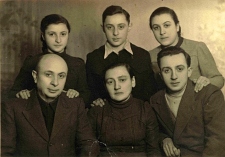Province
Jewish Historical Commission
Bialystok, 14 May 1946
L.p. 5/46Deposition of Menachem Finkielsztejn
Resident of Radzilow, age 22
22 June 1941 was the start of the war. The two districts
are adjacent. The first line of Germans overran the district without doing any damage. A
week later, the Polish police allied with the Germans, entered the houses. The Germans
terrorized and the Poles looted. The Poles asked the Germans what penalty there was for
killing Jews. The Germans replied that killing Jews was not a crime. A week later the
Germans left. The Poles would enter Jewish homes at night to terrorize and rob.
|
|
|
|

|
|
Finkielsztejn Family
Upon arrival in Israel, 1946
[Bottom row L-R]: Yisrael Finkielsztejn, wife Chaya (nee
Wasersztejn) Finkielsztejn and eldest son Menachem
[Top row L-R]: Chana, Sholem, Yaffa
Entire family of six survived the Holocaust
Went to Israel, 1946 |
|
| |
|
5 July, the Polish police surrounded the little village of
Wasosz (district of Grajewo). The hooligans went from door to door murdering inside and
outside the Jewish houses. They raped the women, cut off their breasts and threw children
against the walls. Also killed were the wives of the Soviet commandant and Soviet workers.
The fingers of the cadavers were cut off to secure any jewelry and teeth were removed from
the mouths for the gold. Any surviving children were killed while their parents watched
and then they killed the parents. The pogrom lasted 3 days, the amount of time the Germans
allowed the Poles for murder and robbery. Graves were dug and the bodies were buried. In
the course of this 1200 Jews perished (the town had about 800 Jews but more were brought
from other places). About 15 people survived until June 1942 in Wasosz. The Germans
behaved well but the Poles could kill and plunder at will.
1 June 1942, a model farm was created in Milewo, community
of Szczuczyn. This was on the property of a landowner from Grajewo. All the Jews were
moved there as well as the Jews from neighboring villages, all together 500 people. The
people were worked extremely hard from dawn to night. Supervisors were the Poles. Even the
children were worked very hard. Shelter was very meager and there was terribly severe
discipline.
2 November 1942, they were deported to the village of
Bogusze on the German border. There was a former camp there where Soviet and Polish
prisoners were literally worked to death. They were kept in this camp until January 1943
when they were sent to their deaths in Majdanek and also Treblinka.
In Bogusze there were no houses for the Jews. They slept
outside in the fields and were thrown raw potatoes. Those that caught them ate. Half of
the Jews died on this spot.
Stories were told that Soviet prisoners in the barracks
were starved to death. There was one Jew that possibly survived. His name, Mroczek from
Kolno (now in Lomza).
7 July 1941, the Polish hooligans who were armed with
rifles and pistols by the Germans burned approximately 1500 Jews in Radzilow, community of
Bialystok (100 from Radzilow and 500 from Szczuczyn, Jedwabne, etc.). This pogrom lasted 3
days. 22 Jews hid and they survived, including the family of Finkielsztejn (father,
mother, 4 children, and one cousin who perished later - Zina Wasersztejn). The Finkielsztejn's
were hidden in the village of Konopki-Blonie, community of
Hawiski, Lomza
district. Other Jews stayed in Radzilow. After a month, the Jews remaining there were
housed in a synagogue. They were forced into intense labor removing heavy stones from the
Radzilow River [Radzilowka River] to build a bridge. This lasted 3 weeks. The Jews bought
themselves out at the office of the police commander (Konstanty Kiluk). He allowed them to
live in one of the Jewish houses on Koscielna Street. They were required to do heavy
labor (street cleaning, etc.). This lasted until 1 June 1942. Meanwhile, they arrested
Benjamin Kruk, Szapsa Moruszewski and others for being communists. They disappeared
without a trace.
1 June, the people were deported to Milewo. The only
survivors were the Finkielsztejn's, Mojzez [Moshe] Dorogoj and his son Akiwa (they perished
28 January 1945, one week after the liberation by the Red Army). They were killed by the
Poles in the village of Itucz, community of Radzilow.
|
|
Destruction of the Village of
Jedwabne 11 July 1941 (also 3 days):
Translation from Polish, page 234 of the Grajewo Yizkor
Book*
Before the war there were 2800 Jews there. They were all burned in a barn. The first in
the death procession was the Rabbi and the butcher. The Rabbi carried a portrait of Stalin
and the rest of the Jews carried red flags. As they passed before the monument of Stalin
they were told to kiss his feet and cheer in his honor. As in Radzilow, the second day,
the Poles went into the burnt remnants of the barn and pulled gold teeth from the jaws of
the cadavers. 3300 Jews perished (3000 were burned, the rest were found and killed in the
following 2 days). There were 302 that survived. They remained in Jedwabne in 3 houses
until 11 February 1942. However, 15 from among them, due to some Polish provocation (the
Jews were accused of hanging anti German banners), disappeared . . .
2 November 1942, the rest, along with the inhabitants of
the Lomza ghetto were taken to Zambrow and then in January to Treblinka? . . .
Those left were Zyna Cukierbraun and 3 males (the males are
in Jedwabne and Zyna is in Warsaw).
Witness:
Protocolant:
Jewish Historical Commission: M. Turek, Mgr.
|